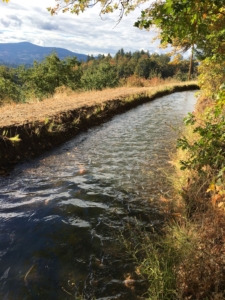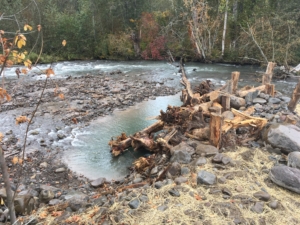Watch a recording of the Neal Creek Phase 1 Habitat Restoration Project presentation.
Neal Creek is an important clearwater (non-glacial) tributary to the lower Hood River, which provides habitat for threatened winter steelhead, threatened coho salmon, cutthroat trout, and resident rainbow trout. Over the past 100 years, numerous human activities have altered the Neal Creek Watershed through logging practices, relocating stream channels, and placing roads and buildings in its floodplain. This has resulted in stream channels with fewer pools, less spawning gravel and instream wood, and reduced side channel habitat. Fortunately, there are opportunities to restore sections of Neal Creek to provide better fish habitat and aid in the recovery of steelhead and coho.
The Hood River Watershed Group, in partnership with the Confederated Tribes of the Warm Springs and private landowners, has been developing a series of restoration projects along Neal Creek that aim to restore the ecological processes of the Neal Creek Watershed and ensure the health and viability of ESA-listed salmonid populations with the improvement of spawning, rearing, and overwintering habitat. The first phase of this work was completed in August of 2021 and restored approximately 1/2 mile and two acres of habitat by constructing six log jams, creating 14 pools, and adding over 100 logs back into Neal Creek.
The project was funded by the Confederated Tribes of the Warm Springs, Oregon Watershed Enhancement Board, and Pacific Power Blue Sky Habitat Funds/The Freshwater Trust, and was designed by Parr Excellence. Alix Danielsen, the Hood River Watershed Group Restoration Project Manager, and Bill Norris, the project engineer with Parr Excellence, will provide an overview of the project and discuss future work planned along Neal Creek.
 DNA (eDNA) sampling for fish in streams is the collection of DNA released by a target species into the water. Scientists at the U.S. Forest Service’s National Genomics Center for Wildlife and Fish Conservation have pioneered developments in this field. Dan Mason, with the National Genomics Center, describes how and why eDNA for fish is collected, along with results from bull trout and Pacific lamprey data in the Hood River Watershed and beyond.
DNA (eDNA) sampling for fish in streams is the collection of DNA released by a target species into the water. Scientists at the U.S. Forest Service’s National Genomics Center for Wildlife and Fish Conservation have pioneered developments in this field. Dan Mason, with the National Genomics Center, describes how and why eDNA for fish is collected, along with results from bull trout and Pacific lamprey data in the Hood River Watershed and beyond.
 The
The 
